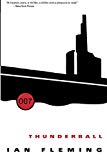
According to continuation Bond author Raymond Benson, there was further development of the Bond character in Thunderball , with glimpses of both his sense of humour and his own sense of mortality being shown. Felix Leiter had his largest role to date in a Bond story and much of his humour came though, whilst his incapacity, suffered in Live and Let Die , had not led to bitterness or to his being unable to join in with the underwater fight scene towards the end of the novel.
Academic Christoph Linder sees Thunderball as part of the second wave of Bond villains: the first wave consisted of SMERSH, the second of Blofeld and SPECTRE, undertaken because of the thawing of relations between East and West, although the cold war heated up again shortly afterwards, with the Bay of Pigs Invasion, the construction of the Berlin Wall and the Cuban Missile Crisis all occurring in an eighteen-month period from April 1961– November 1962. The introduction of SPECTRE and its use over a number of books gives a measure of continuity to the remaining stories in the series, according to academic Jeremy Black. Black argues that SPECTRE represents "evil unconstrained by ideology" and it partly came about because the decline of the British Empire led to a lack of certainty in Fleming's mind. This is reflected in Bond's using US equipment and personnel in the novel, such as the Geiger counter and nuclear submarine.
Already have an account? Log In Now